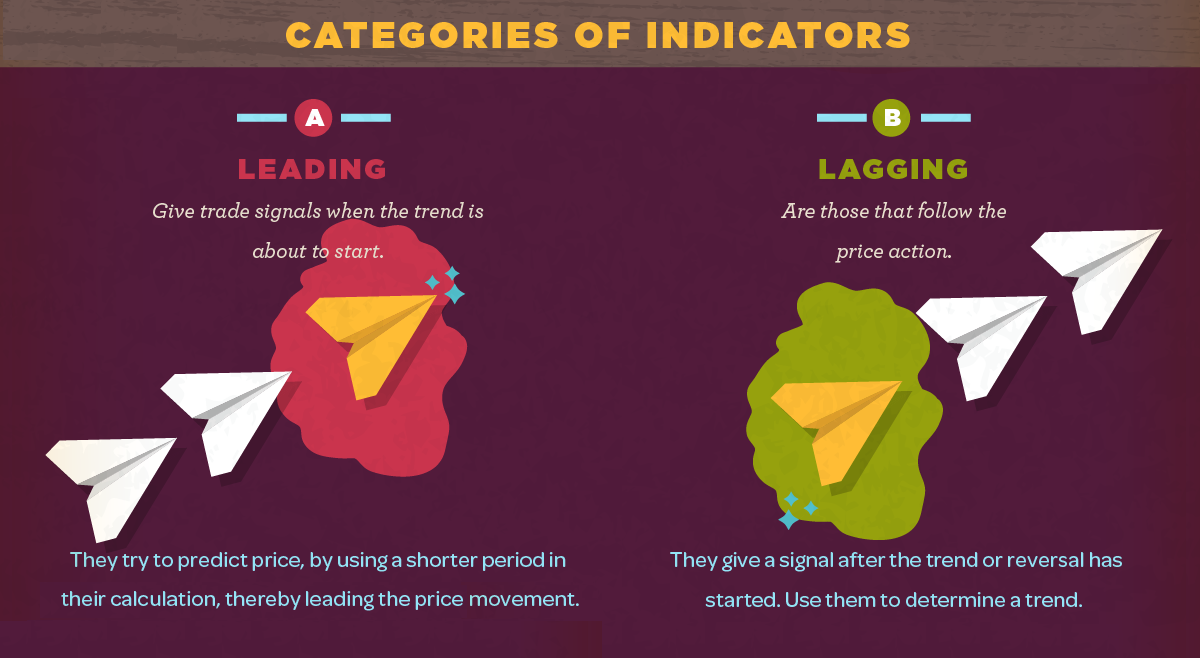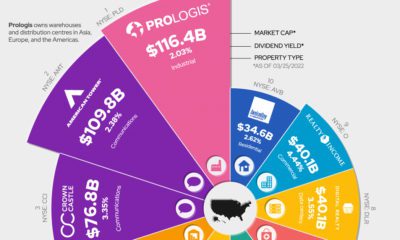However, if you dabble in the stock market on a day-to-day basis, or if you simply want to know what drives the thinking of other market participants, it can be very beneficial to understand the basics of technical indicators. Many traders swear by them to help with the timing of their trades or to alert them of trends. But, even for an investor more focused on the underlying fundamentals of companies, learning how these indicators work can provide added conviction on new or existing trades.
Types of Technical Indicators
Today’s infographic comes to us from StocksToTrade.com, and it explores the fundamentals behind 12 of the most commonly-used technical indicators. It differentiates between lagging and leading indicators, and also explains some basic tactics for incorporating these markers into an overall investment strategy.
The infographic differentiates between four different types, including trend, momentum, volatility, and volume indicators. Trend indicators These technical indicators measure the direction and strength of a trend by comparing prices to an established baseline. Moving Averages: Used to identify trends and reversals, as well as to set up support and resistance levels. Parabolic Stop and Reverse (Parabolic SAR): Used to find potential reversals in the market price direction. Moving Average Convergence Divergence (MACD): Used to reveal changes in the strength, direction, momentum, and duration of a trend in a stock’s price. Momentum indicators These technical indicators may identify the speed of price movement by comparing the current closing price to previous closes. Stochastic Oscillator: Used to predict price turning points by comparing the closing price to its price range. Commodity Channel Index (CCI): An oscillator that helps identify price reversals, price extremes, and trend strength. Relative Strength Index (RSI): Measures recent trading strength, velocity of change in the trend, and magnitude of the move. Volatility Indicators These technical indicators measure the rate of price movement, regardless of direction. Bollinger bands: Measures the “highness” or “lowness” of price, relative to previous trades. Average True Range: Shows the degree of price volatility. Standard Deviation: Used to measure expected risk and to determine the significance of certain price movements. Volume Indicators These technical indicators measure the strength of a trend based on volume of shares traded. Chaikin Oscillator: Monitors the flow of money in and out of the market, which can help determine tops and bottoms. On-Balance Volume (OBV): Attempts to measure level of accumulation or distribution, by comparing volume to price. Volume Rate of Change: Highlights increases in volume. These normally happen mostly at market tops, bottoms, or breakouts. on The good news is that the Federal Reserve, U.S. Treasury, and Federal Deposit Insurance Corporation are taking action to restore confidence and take the appropriate measures to help provide stability in the market. With this in mind, the above infographic from New York Life Investments looks at the factors that impact bonds, how different types of bonds have historically performed across market environments, and the current bond market volatility in a broader context.
Bond Market Returns
Bonds had a historic year in 2022, posting one of the worst returns ever recorded. As interest rates rose at the fastest pace in 40 years, it pushed bond prices lower due to their inverse relationship. In a rare year, bonds dropped 13%.
Source: FactSet, 01/02/2023.
Bond prices are only one part of a bond’s total return—the other looks at the income a bond provides. As interest rates have increased in the last year, it has driven higher bond yields in 2023.
Source: YCharts, 3/20/2023.
With this recent performance in mind, let’s look at some other key factors that impact the bond market.
Factors Impacting Bond Markets
Interest rates play a central role in bond market dynamics. This is because they affect a bond’s price. When rates are rising, existing bonds with lower rates are less valuable and prices decline. When rates are dropping, existing bonds with higher rates are more valuable and their prices rise. In March, the Federal Reserve raised rates 25 basis points to fall within the 4.75%-5.00% range, a level not seen since September 2007. Here are projections for where the federal funds rate is headed in 2023:
Federal Reserve Projection*: 5.1% Economist Projections**: 5.3%
*Based on median estimates in the March summary of quarterly economic projections.**Projections based on March 10-15 Bloomberg economist survey. Together, interest rates and the macroenvironment can have a positive or negative effect on bonds.
Positive
Here are three variables that may affect bond prices in a positive direction:
Lower Inflation: Reduces likelihood of interest rate hikes. Lower Interest Rates: When rates are falling, bond prices are typically higher. Recession: Can prompt a cut in interest rates, boosting bond prices.
Negative
On the other hand, here are variables that may negatively impact bond prices:
Higher Inflation: Can increase the likelihood of the Federal Reserve to raise interest rates. Rising Interest Rates: Interest rate hikes lead bond prices to fall. Weaker Fundamentals: When a bond’s credit risk gets worse, its price can drop. Credit risk indicates the chance of a default, the risk of a bond issuer not making interest payments within a given time period.
Bonds have been impacted by these negative factors since inflation started rising in March 2021.
Fixed Income Opportunities
Below, we show the types of bonds that have had the best performance during rising rates and recessions.
Source: Derek Horstmeyer, George Mason University 12/3/2022. As we can see, U.S. ultrashort bonds performed the best during rising rates. Mortgage bonds outperformed during recessions, averaging 11.4% returns, but with higher volatility. U.S. long-term bonds had 7.7% average returns, the best across all market conditions. In fact, they were also a close second during recessions. When rates are rising, ultrashort bonds allow investors to capture higher rates when they mature, often with lower historical volatility.
A Closer Look at Bond Market Volatility
While bond market volatility has jumped this year, current dislocations may provide investment opportunities. Bond dislocations allow investors to buy at lower prices, factoring in that the fundamental quality of the bond remains strong. With this in mind, here are two areas of the bond market that may provide opportunities for investors:
Investment-Grade Corporate Bonds: Higher credit quality makes them potentially less vulnerable to increasing interest rates. Intermediate Bonds (2-10 Years): Allow investors to lock in higher rates.
Both types of bonds focus on quality and capturing higher yields when faced with challenging market conditions.
Finding the Upside
Much of the volatility seen in the banking sector was due to banks buying bonds during the pandemic—or even earlier—at a time when interest rates were historically low. Since then, rates have climbed considerably. Should rates moderate or stop increasing, this may present better market conditions for bonds. In this way, today’s steep discount in bond markets may present an attractive opportunity for price appreciation. At the same time, investors can potentially lock in strong yields as inflation may subside in the coming years ahead. Learn more about bond investing strategies with New York Life Investments.





























